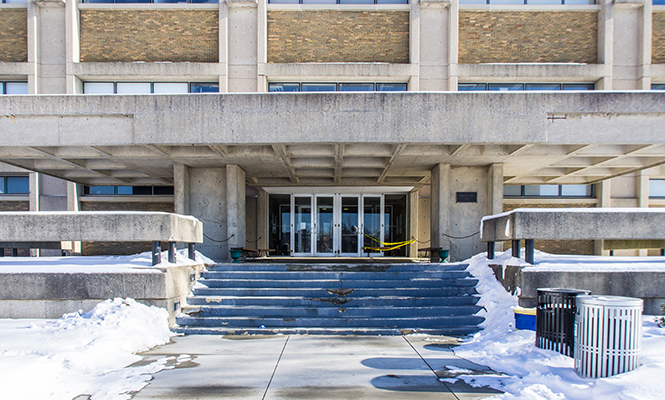Versatile labs in future for science buildings
The entrance of Williams Hall is showing signs of wear and tear due to the building’s age. Williams Hall was built in the late 1960s and has not been renovated since.
February 18, 2014
Kent State could receive $18.5 million in capital funding from the Ohio Higher Education Funding Commission to improve the science facilities. Kent is one of 150 improvement projects endorsed by the commission.
“Our science buildings are in great need, so we are grateful that the state is supporting that need,” Gregg Floyd, senior vice president for finance and administration said.
The state funding will cover a portion of an $80 million renovation and new building project that will start this summer and is projected to be a three-to-four-year effort.
Williams, Smith and Cunningham Halls have not been renovated since they were built almost half a century ago. The university architects have been making plans to renovate the three buildings since last summer as part of the “Foundations of Excellence: Building the Future” initiative approved by the Kent State Board of Trustees in 2012.
Tom Euclide, associate vice president of Facilities, Operations and Planning, said the project will include updates to plumbing, roofing, electrical wiring and the aesthetic look of the buildings.
“We will be looking for ways to improve the buildings, whether it is accessibility or safety upgrades, and at the same time we will be looking to evaluate each of the buildings and start creating plans for an integrated science building,” Euclide said.
In addition to the renovations, designs are being made for an interdisciplinary science building that will hold labs meant for all the science fields.
“A lot of today’s breakthroughs are interdisciplinary, where biology, liquid crystals and chemistry all work together to come up with new things,” Euclide said. “So an interdisciplinary science building will allow us to bring those top researchers closer together to work on projects that cross over into the different fields.”
With an increase in enrollment, James Blank, interim dean of the College of Arts and Sciences, said that the science programs hold about 35 percent of the students in the college and that the expense of a new building is well worth it.
“It’s a building that is going to be serving a lot of students in state of the art teaching facilities and also for research as well.”
Joseph Graham, associate director of Architecture and Engineering, said that the interdisciplinary building would create a more modern setting for the science disciplines.
“The goal will be to make those laboratories very versatile so that as research changes over the years or by the grant, the laboratories can be shifted and moved to accommodate the new needs,” Graham said.
Graham said the plans also include efforts toward a LEED Silver rating, a checklist that evaluates energy efficiency, sustainability and accessibility for people with disabilities for all the buildings.
“The LEED certification will save energy, be most cost efficient in the long-run and hopefully make the buildings last longer with fewer renovations needed,” Graham said.
The university will have to frequently shuffle students and faculty among the buildings in order to renovate while they remain occupied. Renovations are planned to start this summer, and the groundbreaking for the multidisciplinary research labs is estimated to be nine months to a year away.
For more information visit https://www.kent.edu/universityarchitect/projects/index.cfm and visit https://www.ohiohighered.org/capital.
Contact Haley Baker at [email protected].

























